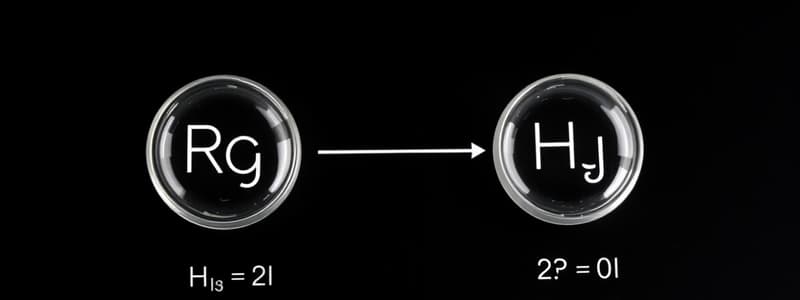Podcast
Questions and Answers
What is reaction stoichiometry based on? What principle does it follow?
What is reaction stoichiometry based on? What principle does it follow?
Law of conservation of mass
Why do we use significant figures? How do you know how many to use?
Why do we use significant figures? How do you know how many to use?
We use measurements. We know how many to use by looking at the number given in the problem.
What can coefficients in a chemical reaction be interpreted as? What are the units you can use to describe them?
What can coefficients in a chemical reaction be interpreted as? What are the units you can use to describe them?
Moles or molecules.
What two units does molar mass compare?
What two units does molar mass compare?
What is the mole ratio of iron(III) phosphate to sodium phosphate?
What is the mole ratio of iron(III) phosphate to sodium phosphate?
How many steps does each type of conversion require?
How many steps does each type of conversion require?
What do ideal conditions mean? What does theoretical yield mean?
What do ideal conditions mean? What does theoretical yield mean?
What different conversions are used when doing the different steps of stoichiometry?
What different conversions are used when doing the different steps of stoichiometry?
Define limiting reactant. Define excess reactant.
Define limiting reactant. Define excess reactant.
Which yield gives you an idea of the efficiency of a reaction?
Which yield gives you an idea of the efficiency of a reaction?
What do balanced chemical equations tell us?
What do balanced chemical equations tell us?
How does the actual yield compare to theoretical yield?
How does the actual yield compare to theoretical yield?
Distinguish between theoretical yield, actual yield, and percentage yield.
Distinguish between theoretical yield, actual yield, and percentage yield.
How many moles of iron(III) phosphate are required to completely react with 7 moles of sodium sulfate?
How many moles of iron(III) phosphate are required to completely react with 7 moles of sodium sulfate?
How many moles of iron(III) sulfate are produced if 85.0 g of sodium sulfate is reacted with excess iron(III) phosphate?
How many moles of iron(III) sulfate are produced if 85.0 g of sodium sulfate is reacted with excess iron(III) phosphate?
How many grams of sodium phosphate are produced if 3.20 mol of iron(III) phosphate are reacted with excess sodium sulfate?
How many grams of sodium phosphate are produced if 3.20 mol of iron(III) phosphate are reacted with excess sodium sulfate?
How many grams of sodium sulfate are required to react completely with 85g of iron(III) phosphate?
How many grams of sodium sulfate are required to react completely with 85g of iron(III) phosphate?
Which is the limiting reactant and which is the excess reactant when 5.00 moles of sodium sulfate and 6.00 moles of iron(III) phosphate are allowed to react?
Which is the limiting reactant and which is the excess reactant when 5.00 moles of sodium sulfate and 6.00 moles of iron(III) phosphate are allowed to react?
Calculate the percent yield if the reaction yields 567g of iron(III) sulfate.
Calculate the percent yield if the reaction yields 567g of iron(III) sulfate.
Write the formula equation and balance: Aqueous strontium chloride reacts with aqueous sodium hydroxide to form solid strontium hydroxide and aqueous sodium chloride.
Write the formula equation and balance: Aqueous strontium chloride reacts with aqueous sodium hydroxide to form solid strontium hydroxide and aqueous sodium chloride.
Stoichiometry is the branch of chemistry that deals with elements in compounds and with reactants and products in chemical reactions focusing on:
Stoichiometry is the branch of chemistry that deals with elements in compounds and with reactants and products in chemical reactions focusing on:
Reaction stoichiometry is based on chemical equations and:
Reaction stoichiometry is based on chemical equations and:
The number of significant figures in an answer to a stoichiometry problem is determined only by:
The number of significant figures in an answer to a stoichiometry problem is determined only by:
In stoichiometry, molar mass is used to:
In stoichiometry, molar mass is used to:
Molar mass can be used to relate:
Molar mass can be used to relate:
Molar masses are determined from:
Molar masses are determined from:
The type of stoichiometry problem that involves the most steps is a:
The type of stoichiometry problem that involves the most steps is a:
The measured amount of product obtained from a chemical reaction is the:
The measured amount of product obtained from a chemical reaction is the:
The efficiency of a chemical reaction is best expressed by the:
The efficiency of a chemical reaction is best expressed by the:
What is the correct mathematical expression for the relationship among percentage yield, actual yield, and theoretical yield?
What is the correct mathematical expression for the relationship among percentage yield, actual yield, and theoretical yield?
Flashcards are hidden until you start studying
Study Notes
Reaction Stoichiometry
- Based on the Law of Conservation of Mass, which states that mass is neither created nor destroyed in a chemical reaction.
- Significance of mole ratios is evident in balanced chemical equations, indicating the proportions of reactants and products.
Significant Figures
- Significant figures (sig figs) are crucial for accuracy in measurements and calculations.
- The number of sig figs used is determined by the given values in the problem.
Chemical Coefficients
- Coefficients represent quantities of substances in moles or molecules.
- They establish the ratios between reactants and products in a chemical equation.
Molar Mass
- Molar mass serves as a conversion factor between moles and grams (and vice versa).
- It is determined from the periodic table, essential for stoichiometric calculations.
Mole Ratios
- In the chemical reaction 2FePO4 + 3Na2SO4 -> Fe2(SO4)3 + 2Na3PO4, the ratio of iron(III) phosphate to sodium phosphate is 2:2.
- Other relevant ratios can be established based on the coefficients from the balanced equation.
Conversion Steps
- Different stoichiometric conversions require varying steps:
- Mass to Mole: 2 steps
- Mole to Mass: 2 steps
- Mole to Mole: 1 step
- Mass to Mass: 3 steps
Ideal Conditions & Yields
- Ideal conditions refer to a scenario where reactions proceed without any losses.
- Theoretical yield is the maximum amount of product formed under perfect conditions.
- Actual yield is the amount produced in an experiment, typically less than theoretical yield.
- Percentage yield measures the efficiency of a reaction, calculated as:
[ \text{Percentage Yield} = \frac{\text{Actual Yield}}{\text{Theoretical Yield}} \times 100 ]
Limiting and Excess Reactants
- The limiting reactant dictates the maximum yield of the product.
- Excess reactants are present in quantities greater than necessary, leading to leftovers.
Yield Calculations
- Comparing actual yield to theoretical yield helps understand the efficiency of reactions.
- For example, in the reaction involving sodium sulfate and iron(III) phosphate, if 567 g of iron(III) sulfate is produced, the calculated percentage yield is 85%.
Balancing Chemical Equations
- To balance a reaction, the correct stoichiometric coefficients must be determined. Example:
- SrCl2(aq) + 2NaOH(aq) -> Sr(OH)2(s) + 2NaCl(aq).
Stoichiometry Fundamentals
- Stoichiometry focuses on mass relationships among reactants and products.
- Different types of stoichiometric problems include mole-to-mole, mole-to-mass, mass-to-mole, and mass-to-mass conversions.
- The most complex problems involve mass-to-mass conversions.
Yield Definitions
- Actual yield is the measured quantity of product from a reaction.
- Theoretical yield is the calculated maximum product amount that could be formed.
- Percentage yield indicates the effectiveness of a reaction and is crucial for evaluating reaction efficiency.
Studying That Suits You
Use AI to generate personalized quizzes and flashcards to suit your learning preferences.




